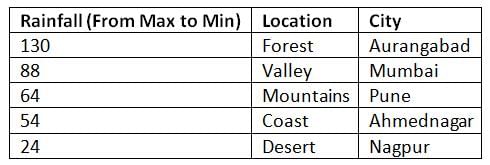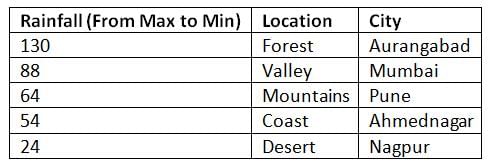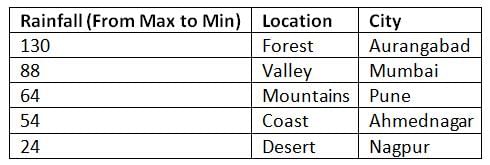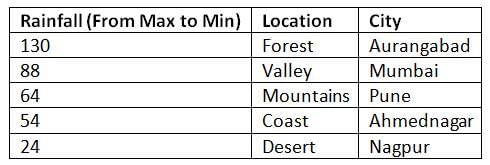Tips and Tricks: Ranking | Logical Reasoning (LR) and Data Interpretation (DI) - CAT PDF Download
| Table of contents |

|
| Understanding Order and Ranking Questions |

|
| How to Solve Order and Ranking Reasoning Questions - Tips and Tricks |

|
| Solved Examples |

|
| Common Mistakes to Avoid |

|
Understanding Order and Ranking Questions
Order and ranking questions involve arranging individuals or objects in ascending or descending order based on specific criteria. Common question types include:
- Determining the rank or position of a person/object from the left, right, top, or bottom.
- Calculating the total number of persons/objects in a row or group.
- Finding the number of persons/objects between two individuals.
- Interchanging positions and analysing the new arrangement.
- Time sequence or floor-based ranking problems.
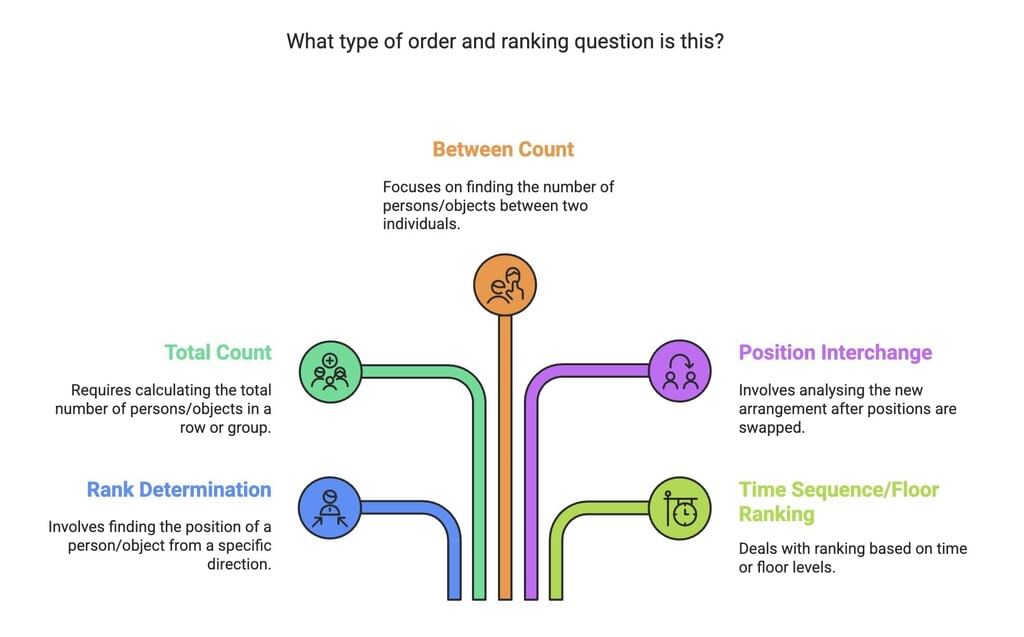
These questions require careful reading, logical deduction, and efficient time management, as time is a critical factor in CAT.
Key Concepts and Formulas
To solve order and ranking questions, understanding the distinction between position and rank is crucial. Position can be from either side of the row (left or right), while rank shows the order from top to bottom and is always based on fixed positions. The following formulas are commonly used:
Total Number of Persons in a Row:
- Total Persons = Rank from Left + Rank from Right – 1
- For example, if Aman is 28th from the left and 33rd from the right, the total is (28 + 33) - 1 = 59.
Number of Persons Between Two People (Non-Overlapping):
- Number of Persons = Total Persons – (Sum of Positions from Opposite Sides)
- This applies when the positions do not overlap, meaning the sum of the positions is less than or equal to the total.
Number of Persons Between Two People (Overlapping):
- Number of Persons = (Sum of Positions from Opposite Ends) – Total Persons – 2
- This is used when the sum of positions from opposite ends exceeds the total number of persons, indicating an overlapping scenario.
Conditions for Overlapping:
- The sum of the positions of two persons from opposite ends must be greater than the total number of persons for overlapping to occur.
- For instance, if Saket is 27th from the left and 34th from the right, and the total is 60, it's non-overlapping, but if the sum exceeds 60, it's overlapping.
How to Solve Order and Ranking Reasoning Questions - Tips and Tricks
Candidates can find various tips, order and ranking reasoning tricks from below for solving the questions that may come in competitive exams:
Tip 1: Memorise the Overlap Formula
Formula: Total (N) = Left Position + Right Position - 1
Use Case: If Arjun is 10th from the left and 15th from the right, total people = 10 + 15 - 1 = 24.
Tip 2: Use Inequalities for Comparisons
Problem: "A > B, C > A, D > C. Who is the tallest?"
Solution: Convert to inequalities: D > C > A > B → D is tallest.
Tip 3: Solve "Between" Questions Instantly
Formula: Number of people between A and B = |Position of A - Position of B| - 1
Example: If A is 7th and B is 12th from the left, people between them = 12 - 7 - 1 = 4.
Tip 4: Handle Swaps/Interchanges
Trick: After swapping positions, the sum of original ranks = sum of new ranks.
Example: If A (rank 5) and B (rank 10) swap, A’s new rank = 10, B’s new rank = 5.
Tip 5: Start with Definite Information
Problem: "A is 4th from left. B is 2 places behind A. C is 5th from right."
Approach: Fix A’s position first (4th), then B (6th), then relate C.
Tip 6: Avoid Overcounting
Trick: Subtract 1 in overlap formula to exclude the person counted twice.
Example: "15th from left + 20th from right ≠ 35 people. It’s 34!"
Tip 7: Use Variables for Complex Sequences
Problem: "A is ahead of B but behind C. D is between A and B."
Solution: Assign positions: C > A > D > B.
Solved Examples
Directions for Questions 1 to 5: Read the details below and answer the questions that follow.
Due to astrological reasons, a mother named all her daughters with the alphabet 'A' as Aadhira, Aadya, Aarohi, Aarna, Aaradhya and Aditi.
(i) Aadhira is not the tallest, while Aarna is not the most qualified.
(ii) The shortest is the most qualified amongst them all.
(iii) Aditi is more qualified than Aadya, who is more qualified than Aarohi.
(iv) Aadhira is less qualified than Aadya but is taller than Aadya.
(v) Aditi is shorter than Aarohi but taller than Aaradhya.
(vi) Aarohi is more qualified than Aadhir, while Aadya is taller than Aarohi.
(vii) Aarna is the least qualified amongst the daughters.
Q1. Who is the third-tallest starting in decreasing order of height?
(a) Aadhira
(b) Aadya
(c) Aarohi
(d) Aaradhya
Ans: (b)
Sol: From the 1st statement we can conclude that Aadhira is not the tallest, Aarna is not most qualified
From the 2nd statement we can conclude that shortest is most qualified
From the 3rd statement we can conclude that in terms of qualification Aditi>Aadya>Aarohi
From the 4th statement we can conclude that in terms of qualification Aadya> Aadhira. And in terms of Height Aadhira>Aadya
From the 5th statement we can conclude that in terms of height Aarohi> Aditi>Aaradhya
From the 6th statement we can conclude that in terms of qualification Aarohi>Aadhira. And in terms of height Aadya > Aarohi
From the 7th statement we can conclude that Aarna is least qualified
Now, order of height is :- Aarna> Aadhira>Aadya>Aarohi>Aditi>Aaradhya
In order of qualification :-
Aaradhya>Aditi>Aadya> Aarohi>Aadhira>Aarna
Aadya. Option (b) is correct.
Q2. Who is the most qualified?
(a) Aadya
(b) Aarohi
(c) Aarna
(d) Aaradhya
Ans: (d)
Sol: From the 1st statement we can conclude that Aadhira is not the tallest, Aarna is not most qualified
From the 2nd statement we can conclude that shortest is most qualified
From the 3rd statement we can conclude that in terms of qualification Aditi>Aadya>Aarohi
From the 4th statement we can conclude that in terms of qualification Aadya> Aadhira. And in terms of Height Aadhira>Aadya
From the 5th statement we can conclude that in terms of height Aarohi> Aditi>Aaradhya
From the 6th statement we can conclude that in terms of qualification Aarohi>Aadhira. And in terms of height Aadya > Aarohi
From the 7th statement we can conclude that Aarna is least qualified
Now, Order of Height is :- Aarna> Aadhira>Aadya>Aarohi>Aditi>Aaradhya
In Order of qualification :- Aaradhya>Aditi>Aadya> Aarohi>Aadhira>Aarna
Aaradhya. Option (d) is correct.
3. What is the rank of Aarohi in increasing order of qualification?
(a) 2
(b) 3
(c) 5
(d) 4
Ans: (b)
Sol: From the 1st statement we can conclude that Aadhira is not the tallest, Aarna is not most qualified
From the 2nd statement we can conclude that shortest is most qualified
From the 3rd statement we can conclude that in terms of qualification Aditi>Aadya>Aarohi
From the 4th statement we can conclude that in terms of qualification Aadya> Aadhira. And in terms of Height Aadhira>Aadya
From the 5th statement we can conclude that in terms of height Aarohi> Aditi>Aaradhya
From the 6th statement we can conclude that in terms of qualification Aarohi>Aadhira. And in terms of height Aadya > Aarohi
From the 7th statement we can conclude that Aarna is least qualified
Now, Order of Height is :- Aarna> Aadhira>Aadya>Aarohi>Aditi>Aaradhya
In Order of qualification :- Aarohi is 3rd if we place them in increasing order of qualification. Option (b) is correct.
4. What is the rank of Aadhira in increasing order of height?
(a) 3
(b) 5
(c) 4
(d) 2
Ans: (b)
Sol: From the 1st statement we can conclude that Aadhira is not the tallest, Aarna is not most qualified
From the 2nd statement we can conclude that shortest is most qualified
From the 3rd statement we can conclude that in terms of qualification Aditi>Aadya>Aarohi
From the 4th statement we can conclude that in terms of qualification Aadya> Aadhira. And in terms of Height Aadhira>Aadya
From the 5th statement we can conclude that in terms of height Aarohi> Aditi>Aaradhya
From the 6th statement we can conclude that in terms of qualification Aarohi>Aadhira. And in terms of height Aadya > Aarohi
From the 7th statement we can conclude that Aarna is least qualified
Now, Order of Height is :- Aarna> Aadhira>Aadya>Aarohi>Aditi>Aaradhya
In Order of qualification :- Aarohi is 3rd if we place them in increasing order of qualification. Option (b) is correct.
Aadhira is 5th if we place them in increasing order of height. Option (b) is correct.
Q5. Who is the tallest girl?
Ans: From the 1st statement we can conclude that Aadhira is not the tallest, Aarna is not most qualified
From the 2nd statement we can conclude that shortest is most qualified
From the 3rd statement we can conclude that in terms of qualification Aditi>Aadya>Aarohi
From the 4th statement we can conclude that in terms of qualification Aadya> Aadhira. And in terms of Height Aadhira>Aadya
From the 5th statement we can conclude that in terms of height Aarohi> Aditi>Aaradhya
From the 6th statement we can conclude that in terms of qualification Aarohi>Aadhira. And in terms of height Aadya > Aarohi
From the 7th statement we can conclude that Aarna is least qualified
Now, Order of Height is :- Aarna> Aadhira>Aadya>Aarohi>Aditi>Aaradhya
From the order of height we can see that it is Aarna.
Directions for Questions 6 to 9:
Five cities all got more rain than usual this year. The five cities area: Aurangabad, Ahmednagar, Pune, Mumbai and Nagpur. The cities are located in five different areas of the country: the mountains, the forest, the coast, the desert, and in a valley. The rainfall amounts were: 24 inches, 54 inches, 64 inches, 88 inches and 130 inches.
(i) The city in the desert got the least rain; the city in the forest got the most rain.
(ii) Pune is in the mountains.
(iii) Aurangabad got more rain than Mumbai.
(iv) Ahmednagar got more rain than Nagpur, but less rain than Pune.
(v) Mumbai got 88 inches of rain.
(vi) The city in the mountains got 64 inches of rain; the city on the coast got 54 inches of rain.
Q6 Which city is in the desert?
(a) Aurangabad
(b) Ahmednagar
(c) Pune
(d) Nagpur
Ans: (d)
Sol: The solution table would be:Hence, the answers are: Nagpur (Option d).
Q7. Which city got the most rain?
(a) Aurangabad
(b) Ahmednagar
(c) Pune
(d) Mumbai
Ans: (a)
Sol: The solution table would be:
Aurangabad (Option a).
Q8. How much rain did Ahmednagar get?
(a) 24 inches
(b) 54 inches
(c) 64 inches
(d) 88 inches
Ans: (b)
Sol: The solution table would be:
Ahmednagar ranked fourth and got 54 inches of rain. (Option b).
Q9. Where is Mumbai located?
(a) The mountains
(b) The coast
(c) In a valley
(d) The desert
Ans: (c)
Sol: The solution table would be:
Mumbai is located in a valley (Option c).
Directions for Questions 10 to 13:
Answer the following questions based on the given information:
In IIT- Delhi, five students A, B, C, D and E take 28. The test has three topics: VLSI, Digital Communication and Microwave Engineering, and the cutoff scores of these three sections are - 22, 25 and 20, respectively. The maximum possible score on each of these three subjects is 100. The student who scores the highest marks gets 1st rank, and the one who scores the 2nd highest marks gets 2nd rank and so on. The following information is given about the scores of these five students:
(i) In a particular subject, the scores obtained by each student are different integers.
(ii) The lowest score in the section was twice the cutoff score.
(iii) For any student, the rank obtained in any two sections was not the same.
(iv) The total score of a student was the sum of scores obtained in all three sections.
(v) For any section, the difference between the highest and the lowest score was 4.
(vi) An overall topper is a student whose overall score is greater than all other students.
Q10. Which of the following can be the maximum possible score of the overall topper?
(a) 134
(b) 142
(c) 144
(d) 143
Ans: (d)
Sol: The highest possible score of the topper = Total score of the student when he gets 1st, 2nd and 3rd rank in these 3 subjects because from statement 3, no student can have the same rank for any 2 sections so he cannot have 1st rank in all. Also, please note that the order of these ranks in respective subjects is not important.
We'll get the same result if we consider this highest scorer scoring 1st, 2nd or 3rd rank in any of the subjects.
Take any case to find answer, say 48 + 53 + 42 = 143. Hence, option (d) is the answer.
Q11. Which of the following is the least possible score of a student?
(a) 131
(b) 137
(c) 128
(d) None of these
Ans: (b)
Sol: Minimum possible marks would be obtained if the scorer scores 5th, 4th and 3rd ranks.
From same logic as in Q10, we calculate the least score as 46 + 51 + 40 = 137.
Hence, option (b) is the answer.
Q12. If the total score of A is the least among all the students, then what can be the maximum possible value of the total score of A?
Ans: A student gets the lowest marks, then his maximum possible marks are calculated by allowing him the least score in one subject, 2nd least in another and maximum in the 3rd, so we get 44 + 51 +44= 139 as the maximum marks obtained by him.
Also, you can try this by trial and error method.
Try to allot marks to these students randomly, you'll learn that the maximum score which is the least amongst all in the group is indeed 139.
Q13. What is the maximum possible difference in total scores of any two students?
Ans: The difference between the two total scores will be maximum when these 2 scores are the highest and lowest scores.
The highest score one can achieve is = 143 The lowest score one can achieve is = 137
Therefore, the required difference = 143 - 137 = 6 is the correct answer.
Common Mistakes to Avoid
- Misreading the Question: Missing small details can lead to incorrect answers. Double-check the question.
- Ignoring Overlapping Cases: Always verify if positions overlap to apply the correct formula.
- Overcomplicating: Avoid reverse engineering unless necessary. Follow the given arrangement logically.
- Time Mismanagement: Don’t spend too much time on one question. Mark it for review and move on.
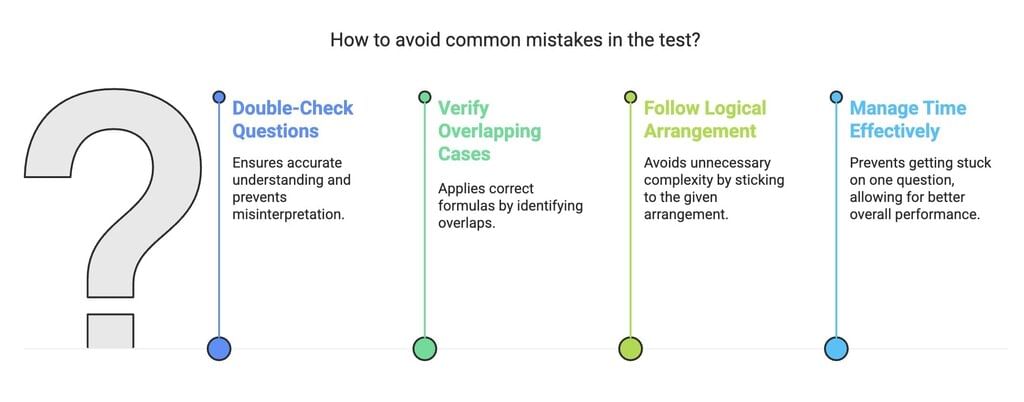
|
77 videos|180 docs|96 tests
|
FAQs on Tips and Tricks: Ranking - Logical Reasoning (LR) and Data Interpretation (DI) - CAT
| 1. What are the basic principles of order and ranking reasoning? |  |
| 2. How can I improve my skills in solving ranking questions? |  |
| 3. What common mistakes should I avoid when answering ranking questions? |  |
| 4. Are there any specific strategies for tackling complex ranking questions? |  |
| 5. How do I manage my time effectively when solving ranking reasoning questions in exams? |  |

